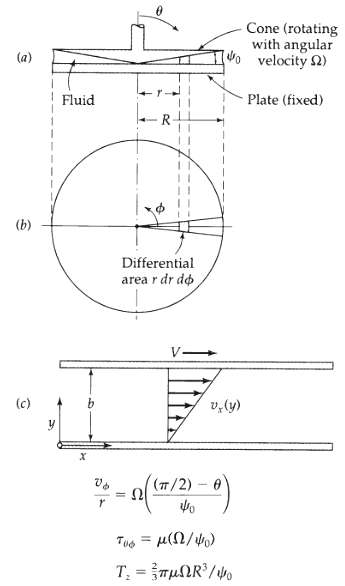The cone-and-plate viscometer (see Fig. 2B.11). A cone-and-plate viscometer consists of a stationary flat plate and an
Question:
The cone-and-plate viscometer (see Fig. 2B.11). A cone-and-plate viscometer consists of a stationary flat plate and an inverted cone, whose apex just contacts the plate. The liquid whose viscosity is to be measured is placed in the gap between the cone and plate. The cone is rotated at a known angular velocity ?, and the torque Tz required to turn the cone is measured. Find an expression for the viscosity of the fluid in terms of ?, Tz, and the angle ?0 between the cone and plate. For commercial instruments ?0 is about 1 degree.
(a) Assume that locally the velocity distribution in the gap can be very closely approximated by that for flow between parallel plates, the upper one moving with a constant speed. Verify that this leads to the approximate velocity distribution (in spherical coordinates) this approximation should be rather good, because ?0 is so small.?
(b) From the velocity distribution in Eq. 2B.11-1 and Appendix B.1, show that a reasonable expression for the shear stress is this result shows that the shear stress is uniform throughout the gap. It is this fact that makes the cone-and-plate viscometer quite attractive. The instrument is widely used, particularly in the polymer industry.?
(c) Show that the torque required to turn the cone is given by This is the standard formula for calculating the viscosity from measurements of the torque and angular velocity for a cone-plate assembly with known R and ?0.?
(d) For a cone-and-plate instrument with radius 10 cm and angle ?0 equal to 0.5 degree, what torque (in dyn ? cm) is required to turn the cone at an angular velocity of 10 radians per minute if the fluid viscosity is 100 cp?

The word "distribution" has several meanings in the financial world, most of them pertaining to the payment of assets from a fund, account, or individual security to an investor or beneficiary. Retirement account distributions are among the most...
Step by Step Answer:






